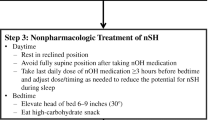Opinion statement
Supine hypertension is a common finding in patients with autonomic failure; it is associated with end-organ damage and produces nighttime pressure diuresis with worsening of orthostatic hypotension. During the daytime, it is best treated by avoiding the supine posture. At night, simple measures such as raising the head of the bed by 6 to 9 inches can be effective, but most patients require pharmacologic treatment. Transdermal nitroglycerin (0.1 to 0.2 mg/h) or nifedipine (30 mg, orally) has proved to be effective. Hydralazine and minoxidil are usually less effective but may be useful in a given patient. One key therapeutic concept is the hypersensitivity of these patients to depressor agents, requiring a careful titration of the doses on an individual basis. For those patients with proven residual sympathetic tone, as in multiple system atrophy, central sympatholytics such as clonidine may provide an alternative.
Similar content being viewed by others
References and Recommended Reading
Consensus statement on the definition of orthostatic hypotension, pure autonomic failure, and multiple system atrophy. The Consensus Committee of the American Autonomic Society and the American Academy of Neurology [no authors listed]. Neurology 1996, 46:1470.
Shannon J, Jordan J, Costa F, et al.: The hypertension of autonomic failure and its treatment. Hypertension 1997, 30:1062–1067.
Asmar R: Benefits of blood pressure reduction in elderly patients. J Hypertens 2003, 21(suppl_6):S25-S30.
Pirpiris M, Cox H, Esler M, et al.: Mineralocorticoid induced hypertension and noradrenaline spillover in man. Clin Exp Hypertens 1994, 16:147–161.
Biaggioni I, Robertson RM: Hypertension in orthostatic hypotension and autonomic dysfunction. Cardiol Clin 2002, 20:291–301.
Vagaonescu TD, Saadia D, Tuhrim S, et al.: Hypertensive cardiovascular damage in patients with primary autonomic failure. Lancet 2000, 355:725–726.
Pathak A, Bourdet B, Montrastuc JL, et al.: Should nocturnal systolic blood pressure be treated in patients with neurogenic orthostatic hypotension? A prospective survival study [abstract]. Clin Auton Res 2004, 14:306.
Omboni S, Smit AA, van Lieshout JJ, et al.: Mechanisms underlying the impairment in orthostatic tolerance after nocturnal recumbency in patients with autonomic failure. Clin Sci (Lond) 2001, 101:609–618.
Kronenberg MW, Forman MB, Onrot J, Robertson D: Enhanced left ventricular contractility in autonomic failure: assessment using pressure-volume relations. J Am Coll Cardiol 1990, 15:1334–1342.
Shannon JR, Jordan J, Diedrich A, et al.: Sympathetically mediated hypertension in autonomic failure. Circulation 2000, 101:2710–2715.
Diedrich A, Jordan J, Tank J, et al.: The sympathetic nervous system in hypertension. Assessment by blood pressure variability and ganglionic blockade. J Hypertens 2003, 21:1677–1686.
Jordan J, Shannon JR, Biaggioni I, et al.: Contrasting actions of pressor agents in severe autonomic failure. Am J Med 1998, 105:116–124. This report compares the effectiveness of several pressor agents used in the treatment of orthostatic hypotension in patients with autonomic failure.
Shannon JR, Diedrich A, Biaggioni I, et al.: Water drinking as a treatment for orthostatic syndromes. Am J Med 2002, 112:355–360. This finding exemplifies the concept that seemingly trivial interventions, such as drinking 500 mL of water, can trigger a potent pressor effect in patients with autonomic failure.
Ammirati F, Colivicchi F, Santini M: Permanent cardiac pacing versus medical treatment for the prevention of recurrent vasovagal syncope: a multicenter, randomized, controlled trial. Circulation 2001, 104:52–57.
Freeman R: Treatment of orthostatic hypotension. Semin Neurol 2003, 23:435–442.
MacLean AR, Allen EV, Magath TB: Orthostatic tachycardia and orthostatic hypotension: defects in the return of venous blood to the heart. Am Heart J 1944, 24:145–163.
Shannon JR, Jordan J, Robertson D: Blood pressure in autonomic failure: drinks, meals and other ordeals. Clin Sci (Lond) 1998, 94:5.
Jordan J, Shannon JR, Pohar B, et al.: Contrasting effects of vasodilators on blood pressure and sodium balance in the hypertension of autonomic failure. J Am Soc Nephrol 1999, 10:35–42. This study compares the efficacy of two vasodilators, nifedipine and nitroglycerin, for the treatment of supine hypertension in patients with autonomic failure. It not only compares the antihypertensive efficacy, but also the effects on nocturnal natriuresis and orthostatic tolerance the following morning.
Author information
Authors and Affiliations
Rights and permissions
About this article
Cite this article
Shibao, C., Gamboa, A., Diedrich, A. et al. Management of hypertension in the setting of autonomic dysfunction. Curr Treat Options Cardio Med 8, 105–109 (2006). https://doi.org/10.1007/s11936-006-0002-1
Issue Date:
DOI: https://doi.org/10.1007/s11936-006-0002-1




